Lisa M. Lilly's Blog, page 10
July 11, 2018
The Sights, Sounds, and Smells of Downtown Chicago
Monday I did something wonderful. I took my first walk through downtown Chicago since late April when I broke my foot. I’m still in an Aircast, but I’m getting around well enough to walk alone.
It felt fantastic.
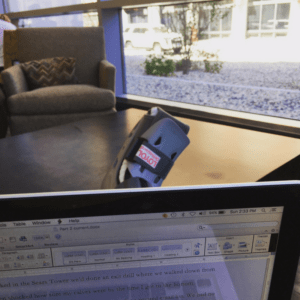
First I walked from my physical therapist’s office to the main Chase bank branch on Monroe and Dearborn. I’d been hoping to sit in the lobby area overlooking the plaza and fountain and rest, but it was under construction. As is everywhere near downtown Chicago these days it seems.
Downtown Chicago Sounds And Smells
On the way, I enjoyed the variety of walking up and down curbs and uneven sidewalks. Also enjoyed skirting street signs (one sideways from recent wind storms) and passing people moving more slowly than me as they stared zombie-eyed at smartphones held out in front of them.
I loved all the city sounds: horns from impatient drivers, conversations all around me in multiple languages, sirens from a few blocks away, seagulls squawking at one another over territory.
And the smells.
Rich caramel and cheese from Garrett’s Popcorn, dark roast coffee, exhaust fumes, the spray of water from a fountain.
It felt as if all my senses had gone on high alert after so many weeks mostly in my condo and then a week outside at the retreat.
I did get outside a bit before that onto my deck. Here’s a view from there of a recent sunset:

I also got to do two of my favorite things in the last two days. One was to read at a coffeehouse, as rather than stop in the Chase building I went on to a Starbucks two blocks away.
A Digression About Starbucks’ Distressing Remodels
This particular Starbucks is on Monroe and LaSalle Streets.
It used to be one of my favorite Starbucks to visit. Unfortunately for me, it’s been revamped and remodeled like many downtown Chicago Starbucks. Gone are most of the comfortable armchairs and nearly all of tables and chairs at a height where I can have my feet on the floor. Now most Starbucks seem to have tall bistro tables that I find far less comfortable.
When there were normal chair and table heights, I used to be able to set my shoulder bag or purse on the floor between my feet and loop the strap over my knee to guard against someone grabbing it without my notice.
The bistro-height chairs require me to choose between hanging my purse or shoulder bag over the back of my chair (a gold-plated invitation to have my wallet stolen), putting in on the floor out of my reach where it can also be easily be snagged, or resting it awkwardly in my lap.
Back To My Favorite Things
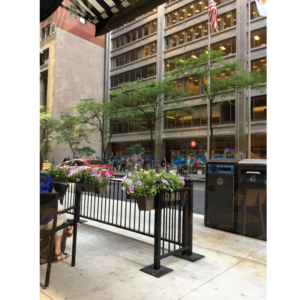
Needless to say, I visit Starbucks a lot less now. But happily Monday I did find one armchair in a corner where I could rest my injured foot on an air conditioning vent, read, and look out the window.
The second thing I love to do is to write at a coffeehouse. (All this despite that I’m not a coffee drinker. I favor tea or hot chocolate.)
And, to my delight, I discovered that a Dollop opened only a couple blocks from me. The closeness makes it easy for me to take my laptop there.
After 2+ months of writing at home at my dining room table (not even in my home office, as I couldn’t put my foot up there) it felt wonderful to write again among the buzz of conversation. And with a view of the outdoors. That’s what you’re seeing just beyond my laptop and Aircast in the very first photo of this post.
After the walk my mood lifted. My writing flowed more freely, and I felt more in touch with the Chicago my characters live in.
I also felt more in touch with the joys of my own life. Not being able to walk for many weeks brought home to me how much I love the city I live in and how many wonderful parts of day-to-day life I’ve been taking for granted.
I hope I’ll remember that even if my recovery continues to progress well and I eventually am completely healed.
The post The Sights, Sounds, and Smells of Downtown Chicago appeared first on Lisa Lilly.
July 4, 2018
This Year’s Retreat
This year’s creative retreat is in Green Bay, Wisconsin.
One of many beautiful sunsets:


Our second day a neighbor warned about a storm coming. So did the sky and lake.
I’ve been working on The Charming Man (Q.C. Davis Series No. 2). Hoping this bug did not die from reading it. But maybe that’s good. Like The Worried Man (Q.C. Davis Series No. 1), it’s suspense/mystery.
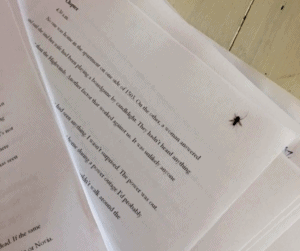
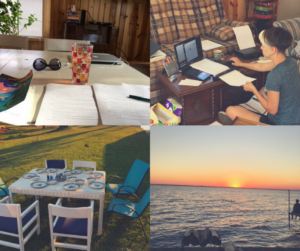
We’re using many different spaces.
Here’s a mini-office my niece created, my writing space, the kitchen table moved outside for dinner, and another view of the lake at sunset.
There’s a bench in the foreground of the photo on the bottom corner, just out of the frame, that’s good for sitting and reading or writing.
Maybe we’ll see fireworks tonight.
The post This Year’s Retreat appeared first on Lisa Lilly.
June 27, 2018
Immigration, Family History, and The Stories We Tell
With all the news and debate about immigration I’ve been thinking a lot lately about family history.
My mom’s parents came to the United States from Poland in the early 1900s. My grandfather emigrated first. My grandmother planned to follow soon after, but due to changes in U.S. immigration law it was nearly a decade before she could.

Two of her children traveled with her. She and my grandfather had four more children, including my mother, after settling in the U.S.
For a long time, I never thought much about that part of my family history. My grandparents died when I was pretty young, and the few Polish words I knew faded out of my vocabulary. (All I can say now is the equivalent of “How are you?” and “Fine.”)
Early Hard Times
Starting out in the United States, things probably didn’t seem too great to my grandparents. They were poor—as in, not enough to eat and sleeping around the stove in the kitchen during winter poor.
My grandmother had cleaned houses in Poland and she did so again in the United States. At least some of the time my grandfather couldn’t find work. My mother told me she got made fun of at school for wearing clothes with patches and because the kids saw my grandfather working in the street as part of a work/welfare program.
My uncles told me one winter they stole sleds from a nearby orphanage. It’s a terrible thing to do, which they realized as adults, but they said they were so envious because people gave sleds and other toys to the orphans, while my uncles and their siblings never had any. (My mom first heard that story when I did, when she she was already in her seventies. She was shocked. She remembered the sleds but had never known where they’d come from.)
My grandparents never learned to speak English.
My aunts and uncles had limited opportunities for education. My mother was quite proud of being the only girl in her neighborhood to finish high school.
Values
My aunts and uncles were the hardest working people I’ve ever known. Sometimes to a fault.
One of my cousins told me it never occurred to him to take a vacation from his high stress job because his father (my Uncle John) worked six days a week and never took a vacation. My cousin didn’t realize that was a thing that people did.
My parents, aunts, and uncles all felt strongly about the privilege of growing up in the United States. All three of my uncles served in the United States Armed Forces with distinction during World War II. I still have an article from the local paper about that.
My aunts and uncles highly valued education for their children. Those children–all middle aged and older now–include lawyers (one who clerked for the United States Supreme Court), CPAs, writers, professors, musicians, and pretty much any type of occupation you can imagine. (I have a lot of cousins.)
Family members also helped one another.
When one of my aunts had four children in quick succession, the other sisters and sisters-in-law came over and helped wash diapers and care for the kids. When one of my adult cousins became ill for a long time, my mom was among those who took shifts getting her through each day.
Most of our parents now deceased, and my cousins and I don’t see each other all that often. All the same, I feel certain if I were in trouble or needed advice I could find it within my extended family.
My parents and most of my aunts and uncles volunteered in their churches, for veterans organizations and other non-profits, and in their communities. It was something I thought everyone did until I got older and discovered not everyone made those types of commitments.
Different Views
I never talked with my aunts and uncles or parents about issues relating to border crossing.
But one evening at my Aunt Hermie’s house the subject of bilingual information and education came up. Chicago was posting more and more signs and instructions at government offices in Spanish as well as English. More schools were providing some amount of bilingual education.
My Aunt Irene expressed anger about this practice.
She said that her family had to learn English and if people came to this country that’s what they should expect to do.
My Aunt Hermie thought there might be some value to having help available in multiple languages.
Unlike Irene and my mother, Aunt Hermie was born in Poland. She spoke only Polish on arrival to the United States. She was put into a class with second graders although she was twelve years old. The other kids made fun of her, seeing her as old and stupid. She dropped out of school and went to work instead in a laundry where she worked for many, many decades.
This family history might be why my mom volunteered for many years as a literacy tutor for people for whom English is a second language. It was something she enjoyed doing, and she felt so pleased whenever anyone made progress.
Life And Fiction
Characters exactly like my aunts and uncle don’t appear in my novels, and I haven’t imported wholesale their backgrounds or experiences.
But the idea that people with good intentions can hold strongly opposing views is a theme woven throughout my fiction. And the family stories about determination, hard work, and doing your best to leave the world a better place than you found it are ones I try to be guided by in my life.
So that’s what comes to mind when I think about immigration and family.
The post Immigration, Family History, and The Stories We Tell appeared first on Lisa Lilly.
June 20, 2018
Lawyers, Stress, and Horror
What do horror, being a lawyer, and stress have in common?
All played a part in my life when I worked full time as a lawyer. Also, all factor into the three short stories in the new paperback edition of The Tower Formerly Known as Sears and Two Other Tales of Urban Horror.
I finally released this paperback edition while home recovering from my broken foot–one good thing about the many weeks in the cast.
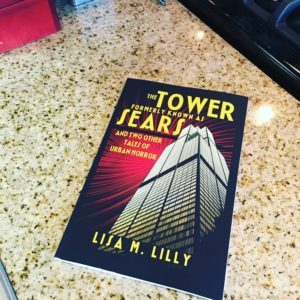
The Man In The Mirror
I’m particularly fond of this story, as it’s the first one I ever sold. (Sort of–the check bounced. But I have a contract that said I’d be paid. Really.)
It takes place during a recruiting event at an amusement park that turns deadly when the attractions develop minds of their own.
It also delves into the mind of the main character. He’s a new lawyer struggling with feeling too much like a grown up kid in his expensive suit, flailing through relationships with female coworkers, and jealous of those around him who gain success faster than he does.
The Merger
In The Merger, a woman struggles with whether to stay in her soulless job after a large corporation swallows her company. She feels her autonomy disappearing, but the money she can earn there beckons.
Many lawyers and clients I worked with struggled with this type of conflict. And many more do now as companies and firms grow larger and larger.
Of course, because this story is part of a collection of Twilight Zone-like tales, the “soulless” part may very well be literal.
The Tower Formerly Known As Sears
In my early drafts of this story, the protagonist was a partner who made life hell for the new attorneys stuck working for him. But as I saw growing pains in the law firm where I worked, I began thinking about it from the perspective of a new leader trying to persuade everyone that change is good.
In this final version, the lawyers push back against the leader. And so does the skyscraper where the firm is located, the Sears Tower (now known as the Willis Tower).
A few years after I published this story as part of the ebook edition, a short film of it was made under the title The Willis Tower. The film takes yet another approach, linking the horror less to the skyscraper listed in the title and more to the protagonist’s psyche.
While the story changed a bit, I loved seeing the director’s take on the narrative. And it was fun seeing actors playing the parts I’d written.
All of which is to say I’m very excited to finally be offering this short book in paperback. Readers asked for it over the years, but it seemed some other project always took priority. Now it’s finally here. This edition includes a sample first chapter from When Darkness Falls, a gothic horror novel set in Chicago’s South Loop.
Enjoy!
The post Lawyers, Stress, and Horror appeared first on Lisa Lilly.
June 13, 2018
A Wheelchair, A Book Fair, And A Lot Of Nice People
This year I felt the most trepidation I ever have about bringing my books to the Printers Row Lit Fest (a/k/a the Printers Row Book Fair). And I had the best time I’ve ever had.
The trepidation came because I’m still not able to put weight on my foot, which has 2 broken bones.
I’m wearing a clunky Aircast, which is better than a regular cast, but still keeps me a bit off balance on crutches. With how crowded the book fair usually is, I felt nervous about getting through the crowds without incident after my 10-12:30 shift finished Saturday.
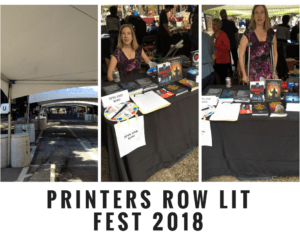
A friend suggested I rent a wheelchair for the day. It worked out–after a wild ride or two–and was a much better way to get back home. And I had a wonderful day.
Learning From Riding To A Book Fair
I’ve never been in a wheelchair before. It’s scary.
Two fantastic friends helped me. Despite trusting them, it was hard to ride in a chair with my injured foot in front of me down a sloping street next to traffic. It felt to me as if I were about to topple in front of cars at any moment.
Once we got onto Dearborn Street, which police had blocked from vehicle traffic, I felt much better.
Before any of that, though, we had to navigate the parking garage.
I only live 4 blocks from the book fair, and had I known what it would be like in the garage we would have walked/wheeled the whole way. The garage turned out to have a steep ramp going up into it, with a narrow sidewalk–again along a vehicle-filled space–to get out.
Happily, an attendant showed me the elevator, which was hidden behind a heavy door. The indoor ramps from the second floor where the elevator let me out to the ground floor, though, were daunting for someone who has never used a wheelchair alone. (My friends were outside with the boxes and bags of books and supplies.) I wasn’t that great at navigating.
Also, the ramps exited at an entirely different place. Lots of texting got my friends there to retrieve me.
Oh, and did I mention it was drizzling? Better than the downpour from earlier the morning. But as I waited I wondered if we were doing all this only to be rained out.
Sitting Behind A Table Of Books
The rain stopped about 10 minutes into the official 10 a.m. opening of the fair, and the morning turned to be the best ever of the five times I’ve rented a table under the Chicago Writers Association Tent.
In other years I’ve sweated through hours of 100 degree temperatures with no shade, ducked flying signs during high winds, and scrambled to secure plastic over the books in driving rain, only to find no one returned to the book fair when the sun came out again.
This year, once the drizzle stopped it was a perfect temperature. A bit cool, not too sunny, no more rain, and just enough wind to keep it comfortable under the tent.
The rain did keep the crowd a bit limited early in the day.
But I liked that too. Fewer people made it seem more relaxed. People felt happy the rain was gone, and stopped to chat about it. If someone came up to my table, it was because they’d been drawn in by a book cover or we’d started talking, not because they’d been basically pushed over to my side of a busy corridor by a crowd.
Standing on crutches turned out to be awkward and uncomfortable, so most of the time I sat in the wheelchair.
While most people suggest standing behind the table to be more visible, I discovered sitting worked better for me. I felt more relaxed. Also, more people stopped to talk to me than in previous years, I think because I wasn’t looming over the table like an overanxious salesperson.
Really Really Nice People
The best part of the book fair, and what left me feeling happy and energized though tired, were the people:
A security guard in the garage wheeled me down the ramp so I didn’t have to try it myself;
The other authors near me offered their chairs and anything else they could do to help;
Book fair patrons were friendly, and we had lovely discussions about books, the weather, the historic Printers Row neighborhood, and my advice about getting a real ladder rather than climbing on a chair if you are getting something down from up high;
Someone from Sisters In Crime, which had a tent across the way, came over to chat with me about the mystery/suspense series I’m writing;
My two friends devoted half their day to lugging me and my books around and checking to see if I needed anything; and
When I returned home, the doorpeople at my building opened the handicap doors for me. They also held onto the wheelchair until it could be picked up by the medical supply company.
Overall, it was one of the best days I had since I broke my foot. And I sold some books!
The post A Wheelchair, A Book Fair, And A Lot Of Nice People appeared first on Lisa Lilly.
June 5, 2018
Please Join Me At Printers Row Lit Fest in Chicago June 9
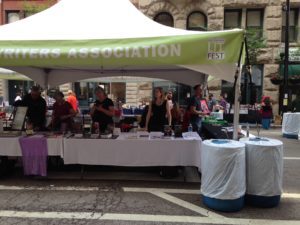 If you’ll be in the Chicago area on Saturday June 9, please stop and say hello at the Printers Row Lit Fest. I’ll be under the Chicago Writers Association Tent Saturday, June 9 from 10 AM to 12:30 PM.
If you’ll be in the Chicago area on Saturday June 9, please stop and say hello at the Printers Row Lit Fest. I’ll be under the Chicago Writers Association Tent Saturday, June 9 from 10 AM to 12:30 PM.
The CWA tent will be between Harrison and Polk on Dearborn Street (so around 700 S. Dearborn).
The Lit Fest (formerly called the Printers Row Book Fair) is open June 9 and 10. It spans Dearborn Street from Congress Parkway to Polk, and there are usually tents along Polk and events in the Harold Washington Library too.
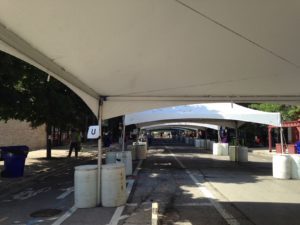 The tents being set up the day before
The tents being set up the day beforeOverall, it’s my favorite summer festival. There are tons of authors, speakers, demonstrations (including cooking demonstrations), talks, events for kids, and books books books.
This year due to my broken foot I’ll be managing on a combo of a wheelchair (necessary to get through the crowds without stumbling) and crutches.
I’m sure it’ll still be tons of fun. I’ll have paperback editions of my latest releases The Worried Man (Q.C. Davis No. 1) and The Tower Formerly Known as Sears and Two Other Tales of Urban Horror, as well as books from The Awakening series and the Writing As A Second Career Series.
Hope to see you there!
Lisa
P.S. Here’s the full schedule of authors under the CWA Tent, and here’s the Printers Row Lit Fest website.
The post Please Join Me At Printers Row Lit Fest in Chicago June 9 appeared first on Lisa Lilly.
May 30, 2018
Our Mothers, Ourselves, Our Fiction
After reading The Worried Man, a friend who’s also read my other books pointed out that my main characters’ mothers aren’t exactly warm and fuzzy.
It’s true.
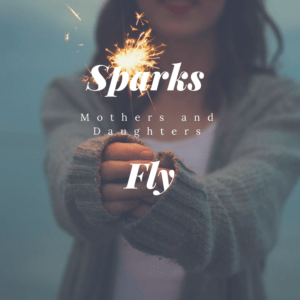 Like a lot of women, my mom and I clashed over many things. What comes through in my fiction are larger than life echoes of those conflicts.
Like a lot of women, my mom and I clashed over many things. What comes through in my fiction are larger than life echoes of those conflicts.
Unfair as it is, the things I admire most about my mom — and there are a lot of them — usually find their way into other characters.
Conflict Conflict Conflict
Storytelling requires conflict. Because of that my protagonists typically have challenging relationships with family members, face situations that make it hard for those around them to support them, or both.
When Tara in The Awakening Series tells her mother she’s pregnant and yet remains a virgin and doesn’t know how this could’ve happened, her mother assumes her daughter is having trouble taking responsibility for her choices.
Also, Tara’s mom is generally hard on her daughter.
Lynette had a difficult childhood. She simultaneously strives to create a better life for her daughter yet envies what she sees as Tara’s easier life and greater opportunities.
Quille, the heroine of my Q.C. Davis mystery/suspense series, has a mom who is essentially not there for her. She has suffered from depression all of Quille‘s life and as a result really never connects with her daughter. Quille‘s grandmother, though, steps in to help raise Quille and remains a tremendous support for her.
In Gram, I instilled many of the things I admire about my mom. Her practicality, reliability, and her determination to raise Quille to be an independent, healthy person all remind me of my mom.
Confidence
I’m still recovering from a broken foot (and still in a cast) so I continue to catch up on reading novels and listening to audiobooks, including non-fiction. Right now I’m finishing The Confidence Code: The Science And Art Of Self-Assurance — What Women Should Know.
While I’m not sure I agree with everything in the book, it has made me see the positive ways my mom influenced choices I made and successes I had.
Try And Try Again
One of the best messages my mom conveyed was about trying and failing. Whenever I didn’t achieve what I wanted, my mom’s answer was that what mattered was not winning but doing your best.
If I tried out for a play and didn’t get the part I wanted, or a part at all, but I had prepared well, showed up on time, and put my whole heart into it, she told me I ought to feel proud of myself. And if I really wanted to be in a play in the future I should keep trying. If I hadn’t done my best, then the next time I better do that and I’d have a better chance of getting the results I wanted.

She also pointed out to me people who hadn’t been good at things to start out — who hadn’t been a “natural“ — and who later excelled.
As a result, when I started learning to play guitar, I didn’t expect to be amazing right away. I knew it would take many hours of practice. I also knew that anyone who was really good had put in those hours.
No Easy Way Out
My mom also set high standards, and she didn’t hesitate to say so if she thought I hadn’t met them. In some ways, that led to me being a bit of a perfectionist, something I have struggled with. But overall, I still feel it was a good message. What she was telling me was that I could almost always do better.
She also taught me not to coast.
When I was little my mom thought I seemed pretty sharp. She started teaching me to read almost before I could talk.
By the time I started school, I was already reading books a few grades ahead. This made my classes pretty boring, but that only caused my mom to push me to enter experimental programs and to try to find more challenges.
Sitting back and taking it easy was never considered to be a good option. There was always more to be learned.
That more than anything is what I appreciate, whether it makes it into the mothers in my novels or not.
The post Our Mothers, Ourselves, Our Fiction appeared first on Lisa Lilly.
May 23, 2018
Books And Shows – What Do You Suggest?
During the 4 1/2 weeks so far that I’ve been at home due to my broken foot, I’ve read tons of books and watched a few new shows.
Here are the highlights:
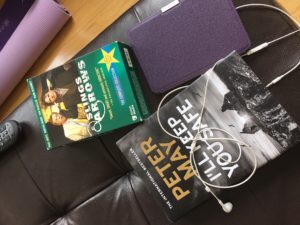
Novels:
The first two Shaye Archer novels by Jana DeLeon. I love these books! Shaye is a young female private eye who just started her business and who has a very difficult past. Already planning to read the rest. I’m spacing them out so as not to finish too fast.
John Sandford’s Twisted Prey. This book is the latest Lucas Davenport novel, and it’s my favorite of the last 5 or 6. Lucas is mostly in D.C. and the emphasis is on detecting more than shooting (though there is some of that too). I love all Lucas books, and I flew through this one no matter how slowly I tried to read.
The Last Lecture by Randy Pausch. Non-fiction, very inspiring and practical. I’ve been listening on Audible, which is wonderful. Getting around now requires crutches or a scooter, and both mean it takes me 2-3 times longer to do everything. (Laundry, that’s a real challenge.)
I’ll Keep You Safe by Peter May. I’m in the midst of this one now. A grief-stricken Niamh returns to her isolated home on a Scottish island after her husband/business partner is killed in what appears to be a terrorist attack. But she soon suspects his murderer had personal motives and that she, too, may be in danger. Excellent atmosphere and quietly-building suspense.
Pride and Prejudice, also on Audible. Yes, again!
The Historian by Elizabeth Kostova. A literary Dracula novel. Beautifully written and fascinating. Also a relisten for me, mostly when I’m worn out. That way if I fall asleep I don’t have any trouble picking up the thread again.
For shows, I’ve started watching the reboot of Lost In Space. Pretty interesting now that the Robinsons have met some other not-so-reputable humans.
Also I’m rewatching Slings and Arrows, a well-written, funny, and compelling comedy/drama about a Canadian Shakespeare theater.
And, of course, Elementary because Lucy Liu is fantastic as Watson.
(I’m doing some writing, too, working on bonus materials for my Awakening series and on revising the first draft of The Charming Man, Q.C. Davis No. 2.)
Any other suggestions?
The post Books And Shows – What Do You Suggest? appeared first on Lisa Lilly.
May 16, 2018
Accidental Discoveries About City Of Chicago Landmarks
In my work in progress, main character Quille searches for a missing woman while trapped in the iconic Chicago apartment complex River City, which might or might not be a Chicago landmark. (The novel is The Charming Man, Book 2 of my Q.C. Davis series.)
Built in 1986, River City has always reminded me of the cylindrical many-windowed building that the cartoon family the Jetsons lived in.
 Inside River City
Inside River CityIf you’re too young to remember, The Jetsons featured a space-age family that got around in flying cars and had a robot maid.
River City’s Story
Architect Bertrand Goldberg designed River City as two S-shaped interconnected towers along the Chicago River where it runs north and south along Wells Street. The apartments all have curved outer walls with lots of windows.
At the time, the neighborhood had almost no residential development.
River City was meant to be a sort of city within a city. It has a 70-slip marina, which is the only one in the city where boats can remain throughout the winter. The complex includes commercial space, over 400 apartments, and an indoor River Road topped by an atrium.
It has a beautiful park about three floors up. You can see its trees from street level.
River City opened to much fanfare, but it fell on hard times through a combination of the 2007 (and on) recession and a flood of the Chicago River.
For about 15 years, it became a condominium building. Recently a real estate development company bought it and is converting it back into rental apartments.
Landmark Or Not?
Right now there’s a lot of construction immediately north of River City.
New buildings are going up and Chicago‘s Riverwalk is being extended. There is a lot of speculation over whether the owners of River City will fix up the building or have it torn down to make way for more shiny new apartment buildings.
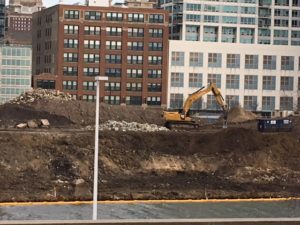
The alderman for the area said once that River City is a landmark that can’t be torn down. This comment surprised me because when I initially researched River City, I didn’t find anything indicating it is a landmark.
While it won’t directly change the events of my story, whether the building is being refurbished or is destined for its demise matters for atmospheric reasons.
So today I did more research.
Two Printing House Rows
I learned a lot about the neighborhood where my protagonist lives (and where I’ve lived for many years).
It’s an area that is very close to downtown Chicago. Many people know it as Printer’s Row. It used to be home to many printing companies and paper warehouses.
One of my older brothers worked at one of those paper companies. I live near it. It’s now high end loft condos. He gave me this wooden drawer he salvaged from one of the printers in the building before everyone vacated it. (Teacups sold separately.)
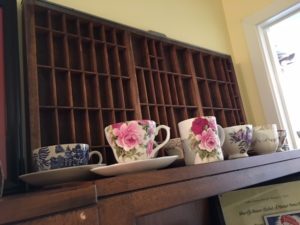
To my surprise, according to the national register of historic places, two neighborhoods are related to Chicago’s printing history.
One is labeled the Printing House Row Historic District.
It’s on the south edge of downtown Chicago, a block or two north of Congress Parkway. (Congress Parkway, a multi-lane street that turns into an expressway going west, defines the south border of downtown.)
The other neighborhood is called the South Loop Printing House District.
That’s the area I’ve always thought of as Printer’s Row, and it’s where the Printers Row Book Fair (now known as Lit Fest rather than Book Fair) takes place on Dearborn Street and Polk Street south of Congress Parkway.
The register gives the boundaries of the South Loop Printing House District as Taylor Street, Polk Street, Wells Street, Congress Parkway, and State Street. I was very happy to learn that. It means I still live with in that district though I’ve moved a little bit away from Dearborn Street.
It also puts Quille directly in the district as well.
Virtual Landmark Tours
The City of Chicago‘s webpages about landmarks include virtual landmark tours.
The tours group and list buildings by topic. They include an African-American History Tour, a Churches and Synagogues Tour, an Early Skyscrapers Tour, a Pre-Chicago Fire Tour, and a Labor and Industry Tour among many others.
If you’ve been following my posts, you know that I broke my foot a little while back.
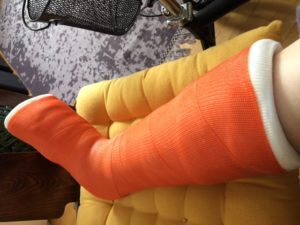 the latest cast
the latest castOnce I’m able to walk about again, I plan to take a few of these tours by printing out the addresses of the buildings and going to visit them. I’m hoping I’ll be able to do that in August or September at the latest.
Seems like a great way to be a tourist in my own city.
I still haven’t found anything showing River City is a landmark. But I can’t say for sure it’s not. The listings may be out of date, or I might have missed some county or state designations.
On the upside, a little uncertainty can only be good for a mystery/suspense series.
The post Accidental Discoveries About City Of Chicago Landmarks appeared first on Lisa Lilly.
May 9, 2018
Pride, Prejudice, and Patience a/k/a Really, I Still Have This Cast?
Launching my latest novel, Book 1 in a new mystery series, while dealing with a broken foot has forced me to confront some things about myself. For instance, I discovered I’m a pretty impatient person.
I can also be my own worst enemy when it comes to living in my head.
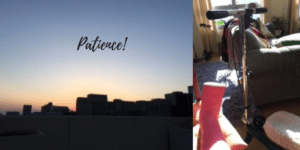
What ifs and worst case scenarios are great for fiction writing. And for foreseeing possible problems when you’re representing a client in a lawsuit. Not so good for mental health.
So here’s what I’ve learned. Or at least am trying to learn.
Worry
In No Girls Here: Naming The Worried Man, I wrote about why I used Girl and not Man when titling my latest novel.
But I didn’t think seriously about why Worry made its way into a title, something that was probably inevitable for one book or another.
My mom was kind of a champion worrier. When my dad unexpectedly needed heart surgery (a problem that fortunately was caught before he had a heart attack) she told me she’d always worried about his back, not his heart, and that was why this had happened.
I thought that was a fluky sort of thinking unique to my mom.
But later I learned it’s pretty common. One self-help book I read on anxiety said something like “Remember, worry has no magic power to stave off bad luck.”
But knowing that your brain is pursuing a path that’s not healthy doesn’t mean it’s easy to stop going down it.
What Ifs
When I first got my cast, it was very tight. It’s supposed to be. As the foot swelling goes down, the cast becomes looser. If it doesn’t start very snug, it’ll get loose too soon and won’t do much good.
All that was explained to me. I still spent the first two nights obsessing over whether I’d wake up with my toes numb. Or my whole leg. And then it would fall off, and I’d probably die, and then….
It’s like a vinyl record album where the needle gets stuck in a groove. (Now that vinyl has made a comeback, I feel safe using that analogy.)
I’d always thought the thing to do was reason myself out of the worry. Yet somehow I always came back to the same scary thought. What I needed to do instead was bounce the needle out of the groove.
I did this at night for the first 2 weeks by relistening to my favorite audiobook edition of my favorite book, Pride and Prejudice read by Shiromi Arserio.
Listening occupied my mind and distracted me from my fears. And I know the story so well that it didn’t keep me from falling asleep when I grew tired.
I hope when I’m recovered and healed, I’ll keep practicing good habits to distract and calm myself.
The Impatient Patient
The doctor warned me this would be a long 6-8 weeks.
Because I broke the bone on which you put most of your weight, I didn’t zip right to a boot and start walking around. I’ve got 2 weeks in this cast (after 5 days in a splint), at least 2 weeks in another cast (which I’ll get Thursday), and then maybe a boot for an unknown amount of time. Then physical therapy.
All the same, I thought I could write as much as I always do, take care of any law projects, and update my bookkeeping while healing.
Uh…no.
I forgot to leave room for being tired. Also for the fact that everyday tasks take two or three times as long on crutches. The same is true with the scooter (shown above).
For the first week, during the 15 minutes every hour that I iced my leg, rather than writing I discovered I needed to rest.
To relax and entertain myself, I finally watched The Lizzie Bennet Diaries. The YouTube series adapts Pride and Prejudice to present day. It’s great fun.
Watching that plus listening to the book reminded me what a fantastic storyteller Jane Austen was. Now I’m thinking that among the next 3 writing books I write will be one about what writers can learn about plot, character development, and narrative techniques from P&P.
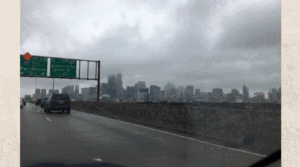
Perspective
As someone who loves loves loves Chicago but finds the cold, mostly gray months of January through March (and often April) a real challenge, I’m hoping this recovery process will give me perspective next winter.
Here’s what I want to remember:
Outside air is great for mental health.
As soon as it grew warm enough for me to open the windows, my cast became 5 times more comfortable and my mood 10 times better.
A reminder that if it’s 45 or above next winter, I ought to open at least one window for a while.
Being able to move and walk freely is a wonderful thing.
My walk to the law school where I teach once a week is a mile.
In the winter and early spring, that often means a walk through icy rain. Or with wind smacking my hair into my face. Or along streets that seem permanently streaked whitish gray with salt.
But walks like that now look like luxuries because walking on crutches with a cast is far more challenging.
Next winter I hope I’ll have good use of my arms and legs. And I hope I’ll appreciate how wonderful that is.
Many people deal with physical challenges every day.
Assuming I’m fortunate enough to recover as expected and I avoid further injury, dealing with a cast and crutches is temporary. But people with longer term or permanent injuries need to navigate a world filled with barriers all the time.
I hope when I’m recovered I’ll appreciate how much easier it is to get around everyday obstacles. Within a block of my home, those include gravel-strewn roads, broken curbs, and blocked sidewalks.
And I’ll do my best to be more aware when someone else might appreciate some help. Friends and strangers alike have been kind. They’ve opened doors, offered rides, and spotted me in difficult situations. I want to be sure to pay that forward.
Happily, I’m finally a little more on track with my writing.
Between yesterday and today, I wrote most of the last quarter of a very rough draft of The Charming Man. (That’s Book 2 in my new Q.C. Davis mystery series.)
Crossing my fingers the rest of the week goes just as well.
The post Pride, Prejudice, and Patience a/k/a Really, I Still Have This Cast? appeared first on Lisa Lilly.



